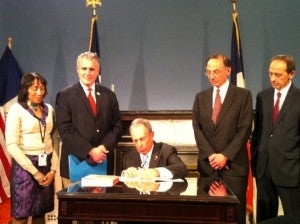Heat Without Fire: Geothermal For A Cleaner, Sustainable Future In New York City
By: Mark Franks, EDF Energy Research Intern

Hurricane Sandy proved that New York City’s energy system is not up to the challenges of the present day. And, as we have highlighted before, the city faces some major challenges to reducing dangerous air pollution caused by heavy heating fuels. One promising solution seeking to significantly reduce NYC’s carbon footprint, improve air quality, and increase grid resiliency during storms is geothermal heat pumps.
The U.S. Environmental Protection Agency (EPA) has called ground source heat pumps the “most energy-efficient, environmentally clean, and cost-effective space conditioning systems available.” Geothermal heat pumps or exchangers, also known as geo-exchange, require no fossil-fuel burning on-site, use 70 percent of their energy from Earth’s renewable sources and are, on average, nearly 50 percent more efficient than gas furnaces.
Last month, I had the honor of watching NYC Mayor Bloomberg sign a bill tasking the New York City Office of Long-Term Planning & Sustainability to study geothermal energy resources and the feasibility of city-wide adoption of geothermal heating and cooling. As Mayor Bloomberg’s sustainability leadership – in an official capacity at least – comes to an end, his plans to ensure that the city’s mission to find sustainable, cost-effective solutions to combat air pollution are well underway. Though the geothermal heating and cooling bill is very important, it is only one aspect of the Mayor’s larger PlaNYC effort.
During his speech, Mayor Bloomberg remarked, “So what is geothermal anyway? I am having it installed in the new place I just bought and I know it works and how much it costs but nothing else.” His words sum up the greatest challenge for geo-exchange yet – lack of awareness. Geo-exchange technology needs our help to move it out of its prolonged infancy and into the mainstream.
The most common misconception holding it back is that geothermal energy will generate electricity, which is only true if you live atop a volcano. Here, in New York, Earth’s sub-surface temperature isn’t quite hot enough to produce electricity. What it does allow for, though, is a cleaner, resilient, and largely cheaper heating and cooling option for thousands of homes and offices – as the tapped heat not only provides heating in the winter, but also air conditioning in the summer.
Under the guidance of Mayor Bloomberg’s PlaNYC, New York City will set the pace for the rest of the country to make way for efficient, non-fossil fuel burning geothermal. There are already a few projects underway in hospitals, museums, schools, and the highly anticipated Cornell Tech Campus on Roosevelt Island that stand to benefit from cheaper heating and cooling, cleaner air and a smaller carbon footprint. The adoption may be challenging, but the reward will be well worth the heat.













3 Comments
We have installed many residential and commercial geo systems and they are amazing, this is the best answer to curb global warming, save money and breath easier, I pray that more tax incentives and more awarness is put out there so that more people get there homes and buissnesses on geo, it also provides hot water, buildings can operate without spewing all those gases into the air, it is time to make changes before it is to late.
thanks.
Jim.
While geoexchange systems can save energy, it is dependent on the electric rate vs the gas rate if they save money. Traditionally the utility cost of natural gas and in some cases propane, while not as energy efficient as geoexchange systems, is cheaper than the electric rate. One needs to be careful when saying that geo systems save money. A detailed analysis of the building and energy bills by an engineer and AEE CGD is recommended before making a claim that a client can save money.
10 cents per kwh = $29.31 per dekatherm when converted. Take a look at a gas bill and it will typically be cheaper than $29.31 per dekatherm
I have designed both systems and prefer the geoexchange and heat pump systems, but always need to be careful when making claims that someone will save money.
If they installed Geo in all those houses being rebuilt it would save a tremendous amount of power generation, and put more disposable money on the street! If they are taking out a loan for repairs adding the cost of Geo would give them positive cashflow from day 1 without having to put a dime out of their savings. Money saved will pay the geo portion of the note and more! Education, education, education, if people only understood the econimics and environmental impact of installing Geo, better payback than solar! Plus they’ll get a tax rebate for 30% of what the Geo cost! Like I always tell my students, your geo customers are anyone with half decent credit, intelligence, and common sense!